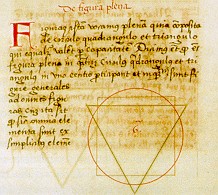- Introduction
- Context
- Life
- Thought
-
Works
- The multilingual nature of Llull's works
- Llull and the catalan language
- Diffusion and preservation
- Book of Contemplation
- Book of the Gentile
- Book of the Order of Chivalry
- Doctrina pueril
- Romance of Evast and Blaquerna
- Book of the Lover and the Beloved
- Ars demonstrativa
- Felix or the Book of Wonders
- Book of the Beasts
- Desconhort
- Tree of Science
- Exemplary Tree
- Cant de Ramon
- Rhetorica nova
- Logica nova
- Liber de fine
- Ars brevis
- Phantasticus
- Ars brevis praedicationis
- Gallery of images
- Database / Dictionary
Vision of the cosmos: analogy and exemplarism
Llull’s basic conception of the world fitted in with the current medieval vision of the universe, with the divine, intelligible and material worlds arranged hierarchically in descending order, with the two created worlds reflecting their divine exemplar. Its relations involved the possibility of arguing for an ascent towards the Creator by analogy with being; a process rendered easier by the fact that both lower worlds could be subdivided into differents levels. Each level possessed an identical structure since it reflected the same common model (though the model revealed itself in different ways on the different levels). These levels, therefore, could genuinely act as rungs upon an immense ladder, by means of which one could ascend as far as God through contemplation of the analogy of being - the celebrated itinerarium mentis in Deum recalled in the title of one of the best-known works of Saint Bonaventure. In the Lullian system, the model which reproduced each level was the specific model of God’s ‘dignities’ or archetypal ‘virtues’: God’s divine attributes, considered as instruments of his creative activity and, therefore, reflected in all aspects of creation, of which they are the very essence of its underlying structure.
The Full Figure represents Llull’s vision of the cosmos.
Source: R. D. F. Pring-Mill, “L’estructura analógica de l’Art lul·liana”, in id., Estudis sobre Ramon Llull (Barcelona: Publicacions de l’Abadia de Montserrat, 1991), pp. 241-242.

Ramon Llull gave enthusiastic expression to a Full Figure constructed in a fairly complicated manner by the ‘squaring’ and ‘triangulation’ of the basic circle such that there resulted a concentric circle, square and triangle of - according to him - equal area, which Full Figure represented the totality of being in all its possible manifestations.
Source: Robert D. F. Pring-Mill, “El microcosmos lul·lià”, in ibid., p. 84.
Palma de Mallorca, Biblioteca Pública, ms. 1036, f. 5v